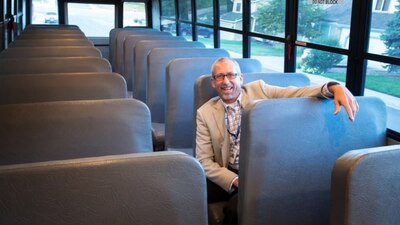The Sheridan School District is small but proud, serving a community that grew up around the Fort Logan military installation southwest of Denver. Nine in 10 students qualify for government-subsidized lunches. Though there have been glimmers of hope academically, the district sits on the state’s watch list for low academic performance and faces sanctions.
The bordering Littleton school district is bigger and better-off. Far fewer students live in poverty, with just 18 percent qualifying for free and reduced-priced lunches. The district is the only in metro Denver to have won the state’s “accredited with distinction” recognition for five years running, and its three high schools regularly make “best of” lists.
The stark socioeconomic contrast between the two Arapahoe County districts earned a dubious distinction this week.
In a report that got a lot of people in the education world talking, the border the school districts share was spotlighted for having some of the largest differences in child poverty rates from one side to the other.
“Fault Lines: America’s Most Segregating School District Borders,” produced by the nonprofit group EdBuild, found that the gulf separating the haves and have-nots along the Sheridan-Littleton border qualified as the ninth largest in the U.S.
To put that in context, the report examined 33,500 school district borders.
The study’s architects used U.S. Census Bureau income and poverty estimates to build their comparisons, not subsidized lunch rates. By the report’s measure, 49 percent of school-age children in Sheridan’s boundaries live in poverty, compared to 9 percent in Littleton’s.
“In present day America, we allow invisible lines to determine the fate of our youngest and most vulnerable citizens,” the report says. “… We’ve created and maintained a system of schools segregated by class and bolstered by arbitrary borders that, in effect, serve as the new status quo for separate but unequal.”
To get their read on the disparities called out in the report, Chalkbeat spoke with the superintendents of the two Colorado school districts spotlighted: Sheridan’s Michael Clough and Littleton’s Brian Ewert.
Neither were surprised the border their districts share would be framed in such a way. Nor do they think the report provides enough context about their districts or how school choice and school finance work in Colorado.

Ewert’s resume includes time at low-income school districts. He took the top job in the roughly 16,000-student Littleton district after a stint in higher-poverty Englewood Public Schools, and after working in San Bernadino, Calif., one of the nation’s most impoverished areas.
“The bottom line is, there is an absolute disparity between school districts with regards to boundaries, poverty, things like that,” Ewert said. “Those are the kinds of things we can’t control.”
One important wrinkle Ewert says the report missed — Colorado’s system of open enrollment, which allows students to attend schools in other districts if there’s room (and families are able to transport their children across district borders).Ewert said that while open enrollment does a lot of good, it can also have unintended consequences. That includes “affluent flight,” or families bolting from schools in their home districts as neighborhoods change and poorer students move in.
Having pockets of poverty, like the Littleton district, makes it easier to devote more money to schools with the greatest needs, Ewert points out. His district has poured resources into high-poverty Field Elementary School, which has posted big gains in state test scores. That is a luxury not enjoyed by districts with high proportions of poor students, he said.
As the EdBuild report notes, chiseling away at income disparities along school district borders is extremely difficult.
A 1974 U.S. Supreme Court case challenging segregation in Detroit Public Schools, Milliken vs. Bradley, found that desegregation efforts cannot be enforced across district borders, cutting off one avenue. Then there’s the fact that district boundaries — unlike, say, congressional districts — are not redrawn as a result of changing demographics.
Consolidation of school districts is one possible answer. The report suggests that the larger the district, the lower the chances of socioeconomic segregation. Van Schoales of the advocacy group A-Plus Colorado floated it as justifiable in this case:
Merging with a high-performing district is one option available to state officials considering consequences for districts such as Sheridan that are chronic low performers and about to run out of time to improve.
The prospect is pretty much a non-starter, however, given the sensitive politics involved and Colorado’s long history of cherishing local control, among other factors.
“I get this question (about consolidation) a lot,” said Clough, the Sheridan superintendent. “Sometimes people are bold enough to say, ‘Why are you still here? Why haven’t you been swallowed up?’ My answer is the same — We were here first.
“This is a community with a longstanding historical tradition of being here to support Fort Logan, the military base that was here a long time. (It closed after World War II). It’s a community with its own identity, its own government. When I took the job, I was told it feels much more like a rural district than our urban counterparts.”

Championing consolidation is based on the false premise that “bigger is better,” Clough said. Some families choice-in to the 1,500-student Sheridan district because of the family feel, he said. (By the way, 117 students living in Sheridan’s boundaries attend Littleton Public Schools).
Not surprisingly, both Clough and Ewert say fixing school funding in Colorado would help with inequities. The state regularly ranks near the bottom nationally in per-pupil funding, and superintendents have fought long and hard to change that.
Although property values are much higher in the Littleton district, Sheridan receives more in state per-pupil funding ($8,220, compared to Littleton’s $6,765) after a number of factors including poverty is taken into account. Higher-income districts like Littleton do have a leg up in passing bond measures and tax increases to support schools.
Ewert argues that the state first needs to adequately fund each student first, then have a conversation about how to provide equitable funding.
“I don’t think tearing down arbitrary community boundaries around school districts solves the problem without a funding solution,” he said. “People say, ‘Well, you can’t solve a problem by just throwing money at it.’ Well, if you throw adequate money at a problem, we can make significant headway.”


